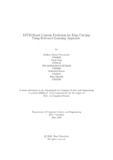Early Schizophrenia Diagnosis with 3D Convolutional Neural Network
Abstract
The proper prediction of schizophrenia at an early stage can be very beneficial to those
who are at risk of developing it at a severe stage later on. The early signs of schizophrenia
include extreme reaction to criticism, staring at something without any expression, in ability to express any kinds of emotion, distancing from family members,unnatural way of
speaking and later the severe signs include showing extreme anger, hallucination, strange
behaviour etc. In order to tackle the problem of diagnosing schizophrenia, researchers
try to extract patterns from neuroimaging data for which various statistical methods and
machine learning algorithms have been explored in the clinical and research applications.
In this paper, fMRI scans of subjects aged between 16 and 30 have been strictly pre processed and then passed into four different 3D CNN architectures to extract and learn
features for the binary classification of schizophrenia. In order to improve performance,
and prevent overfitting, we experimented with different optimizers, batch size and dropout
rate while monitoring these model’s training and validation accuracy. Eventually we found
the optimal set of hyperparameters which best fits these models according to a set of per formance metrics that we have chosen.We finally tested each of these models on the test
dataset and compared the results to deduce the best model suited for our binary classifi cation problem.

